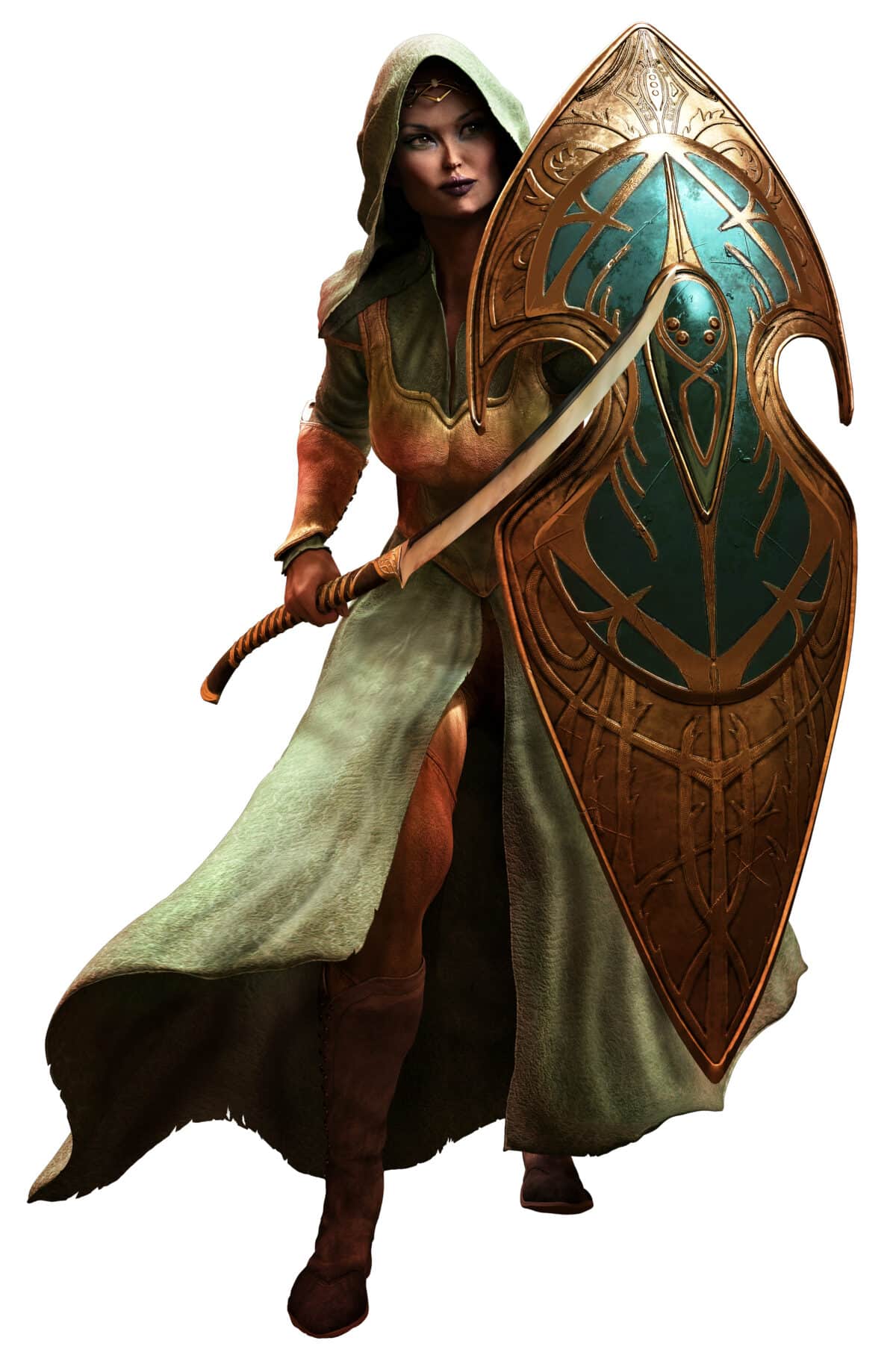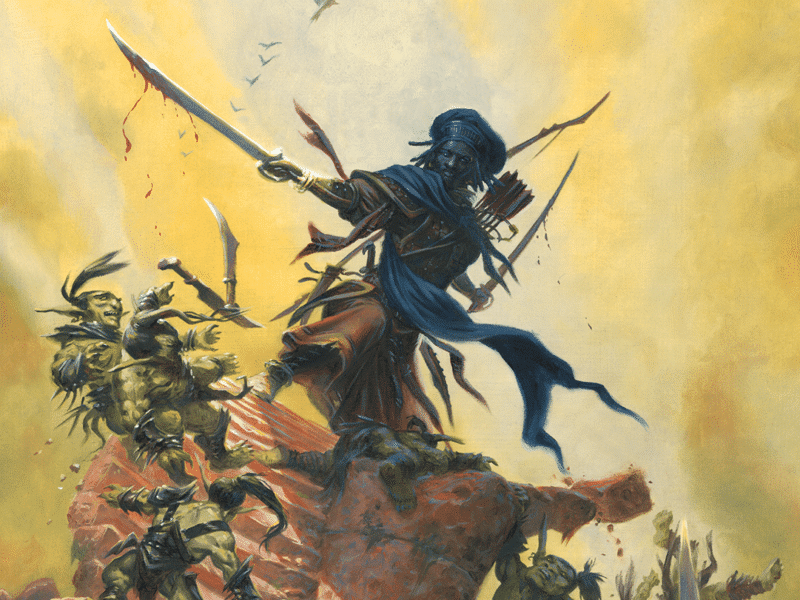A non-player character (NPC) is a person in your adventure who isn’t a player, but is controlled by the Dungeon Master. In short, everyone that your players meet, from a quest-giver or local barmaid to the villain’s right hand and the evil lich is an NPC. NPCs form the backbone of your adventure and the world your players are exploring. Here are more tips and tricks for how to create an NPC and how to make them more interesting!

(Photo credits: Shutterstock.com)
Adventures without NPCs
In general, you can write an adventure without using NPCs. For example, the characters stumble upon a treasure map with a red X on it. They follow the directions and arrive at a cave, which is inhabited by a monster. The characters kill said monster and find the loot. The end.
While this adventure works and ticks all the boxes (Old map – check! Travel from A to B – check! Kill monster – check! Find loot – check!), it isn’t especially engaging or exciting.
Same story, but now with NPCs
Let’s run the same adventure, but this time the players meet a shady dealer called Therix Greycloak, who offers to sell a treasure map to them at a bargain price. The map is authentic, but what the characters don’t know is that Therix is more than willing to sell the map cheaply, since it could otherwise bind him to a crime.
The characters follow the map through the forest, and meet a wood elf ranger, Linas Mïllnaris, on their way. If the characters are friendly towards the elf and tell them about their quest, she tells them that the cave that they are seeking is well-known to her people. It is inhabited by a mighty green dragon, who calls himself Emerald and who is equally sly as vain.
With this information, the characters might want to avoid fighting the dragon and come up with a different plan. Perhaps they will let the bard in the group distract the dragon, while the rest of the party try to steal as much as possible from the treasure while the dragon is preoccupied. The bard in the group can pretend to be a travelling minstrel who has heard about the dragon and wishes to compose a song about it, while the rest of the party tries to stealthily move into the cave and steal as much of the loot as they can. Meanwhile, the shady dealer Therix has framed the characters and they are now wanted thieves.
NPCs are fun and promote roleplaying
In the second example, the characters will engage and roleplay their way through the adventure. They will meet several different NPCs, some of them foes, others friendly, and some downright shady. The second version of this adventure is much more intriguing because of the NPCs. Who is this shady Therix Greycloak? Will the characters meet the ranger Linas Mïllnaris again? And will they manage to fool the green dragon who calls himself Emerald?
This type of story becomes more compelling and interesting because of the NPCs that the characters meet on their quest.
How to create an interesting NPC
The first step to creating an NPC is to give them a name, since it can tell a lot about them. For example, Krush Skullspinter from the Iron Wolf Tribe is a better name than Bob Smithy.
Different races have different types of names, but it can also be fun to add different types of names depending on which region your NPC is from. For example, in my D&D fantasy world, Eastern Farraway, names in the northern region are much more Nordic-inspired and surnames tend to end with “sen” or “dottri” (son of or daughter of), while in the southern part names are more British-sounding with family names that tend to describe professions, such as “Tanner” “Baker” “Hunt” etc.
DM’s tip: Write a cheat list with cool names for different races that you can use when your players meet an NPC.
Flesh out the NPC
Give your NPC a short background story and flesh them out. Which race are they, what do they look like, and what are they normally wearing? Clothes can be a good way to sneakily add context to the NPC so that your players get to draw their own conclusion about the characters. An NPC that enters a tavern wearing mud-stained, worn boots and a damp woollen cloak, is probably a traveller and not a rich, noble merchant.
It is also fun to add something that appears to be against character. For example, if an NPC proclaims himself to be a greatly seasoned adventurer, but the characters notice that his tent and shortbow appear to be brand new and unused, they might just doubt his story. This in turn creates interest: Why is he lying? Perhaps he is young and just wants to sound more experienced, or perhaps he is a nobleman who has recently gone undercover to avoid a marriage that his parents have planned.
DM’s tip: Be careful with how often you introduce evil NPCs who plan to backstab or betray the characters. While it is fun to use this type of trope every now and then, it can lead to trust issues among your players, who might not be willing to interact with NPCs if they fear that they will always try to lure them into a trap, steal their valuables, or double-cross them one way or another.
Ideal, bond, flaw
The rulebooks use descriptions called “ideal, bond, and flaws”, which can be used very effectively for fleshing out your characters, but I prefer to instead use “personality, motivation, and weakness”. Although they are similar, I find it easier to think about someone’s personality (kind, funny, greedy, smart, aloof) instead of their (vague) ideal. I also use motivation (to protect someone, achieve glory, avoid getting caught, revenge) instead of a bond. “Flaw” and “weakness” is almost the same and can be used in a similar manner.
Add a final tweak
I usually add something extra to each NPC. It could be a specific feature (they have a limp, or are unusually tall, or have a crooked nose), or something about their person (they have gold rings on all fingers, they very slowly, or they always look around nervously over their shoulder.)
DM’s tip: If you run out of ideas for NPCs, borrow ideas from your favourite book or movies and mash them together. You can also use real people that you know as a template. For example: What if your best friend were a dragonborn villain?
A connected world
The people in the world are connected to other people and places. Let NPCs be cousins, lovers, friends, or old enemies.
Some NPCs have travelled widely and might share information about other locations that they visited when they were young or during their adventuring years. Other NPCs have never left their village, but might on the other hand know a lot about the village’s surroundings and its history. This can be useful information that the NPCs can share with the characters for their quests.
Gossip and worldbuilding
Remember, not all information that the NPCs shares with the characters have to be useful. Sometimes it is fun to let the NPCs gossip or share information that might not be true. (Having said that, sometimes these nuggets of information or gossip can be used later on for other adventures!)
While most NPCs might be friendly or kind, some will hide secrets or lie. This makes your world more believable and interesting!
When shall we three meet again?
Let your characters form their own relationships with the NPCs. This could be an irksome arch-villain who shows up again and again to taunt the characters, or it could be the same grumpy dwarven innkeeper that the characters meet every time they return to their favourite inn after a quest. You can also let the NPCs be on the move, a travelling bard that the characters have met previously, might show up again at another fair.
This gives a feeling that the world is connected and as a DM you can re-use the NPCs for various roles. Say for example that one of your characters has formed a friendship bond with Krush Skullspinter from the Iron Wolf Tribe, since they are both half-orcs barbarians who share the same love for quaffing mead and arm-wrestling.
If Krush meets the characters again and tells them that he is worried about his half-niece who has disappeared and wonders if the characters might help him search for her, the characters’ incentive to help him will be stronger than if he happened to be a random NPC that they just have met.
DM’s tip: Add plenty of NPCs to your world and keep a notebook with their names, appearance, and manners to quickly remind yourself about who they are.






